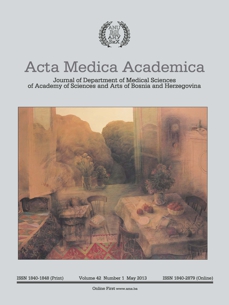An outbreak of multidrug-resistant Serratia marcescens: the importance of continuous monitoring of nosocomial infections
DOI:
https://doi.org/10.5644/ama2006-124.67Keywords:
Nosocomial infection, Phenotyping, Serratia marcescensAbstract
Objectives. Serratia marcescens is a well-established as a nosocomial pathogen, resulting in considerable morbidity and mortality in immunocompromised patients. The aim of this study was to investigate an outbreak of Serratia marcescens at the Orthopaedic Clinic of the Clinical Center University of Sarajevo. Methods. A total of 96 strains from 79 patients were isolated. The isolates were identified by conventional methods. Susceptibility testing was performed by the discdiffusion method following CLSI guidelines. Results were confirmed by VITEC-2 Compact. Results. From January to December 2010, 96 strains from 79 patients were isolated at the Orthopaedic Clinic of the Clinical Center, University of Sarajevo.The strains were isolated from wound swabs, blood cultures and cerebrospinal fluid. The strains were identifed using current phenotypic methods as Serratia marcescens with identical biochemical characteristics and antibiotic susceptibility patterns. All strains were susceptible to imipenem, meropenem, amikacin, ciprofloxacin, levofloxacin and piperacillin/tazobactam. The infection control team was alerted and after investigation they discovered the same phenotype of Serratia marcescens in the anaesthetic vials used in procedures. This outbreak was extremely difficult to terminate, even with cohorting of patients, sterilisation of equipment, reinforcement of handwashing and deep-cleaning of facilities. The implementation of new control measures terminated the outbreak in February 2011. Conclusion. Continuous monitoring of nosocomial infections is indispensable. Phenotypic characterization of the isolates is useful for studying the relationship of microbial pathogens. The relationship of one clinical isolate to another during an outbreak is important in motivating the search for a common source or mode of transmission.Downloads
Published
17.05.2013
Issue
Section
Clinical Science
How to Cite
An outbreak of multidrug-resistant Serratia marcescens: the importance of continuous monitoring of nosocomial infections. (2013). Acta Medica Academica, 42(1), 25-31. https://doi.org/10.5644/ama2006-124.67






